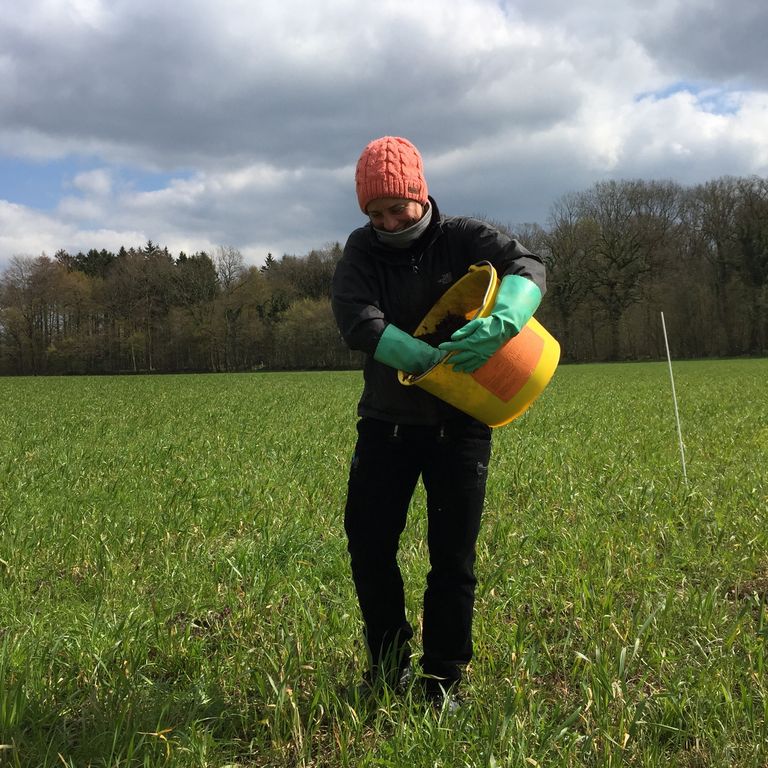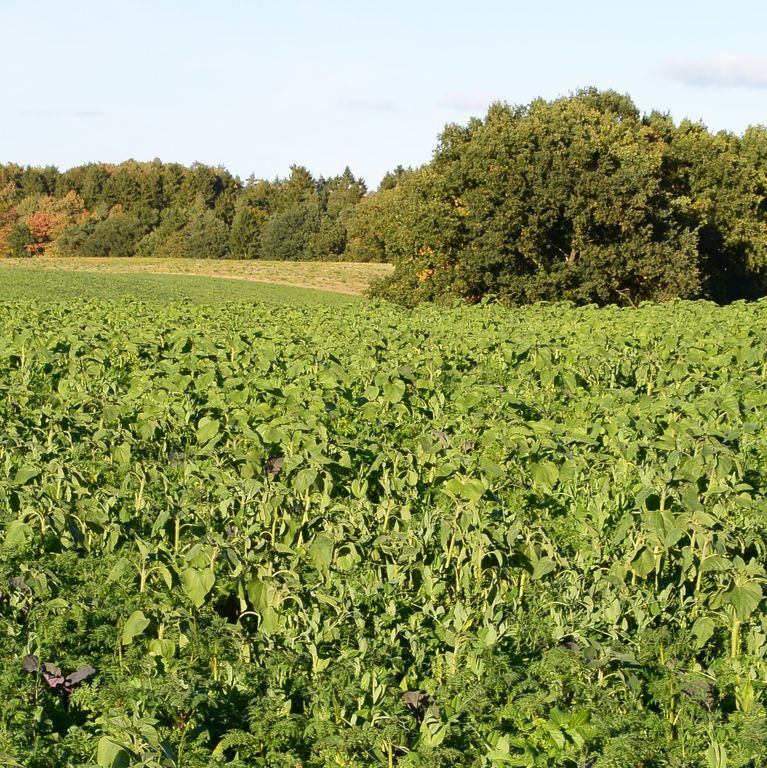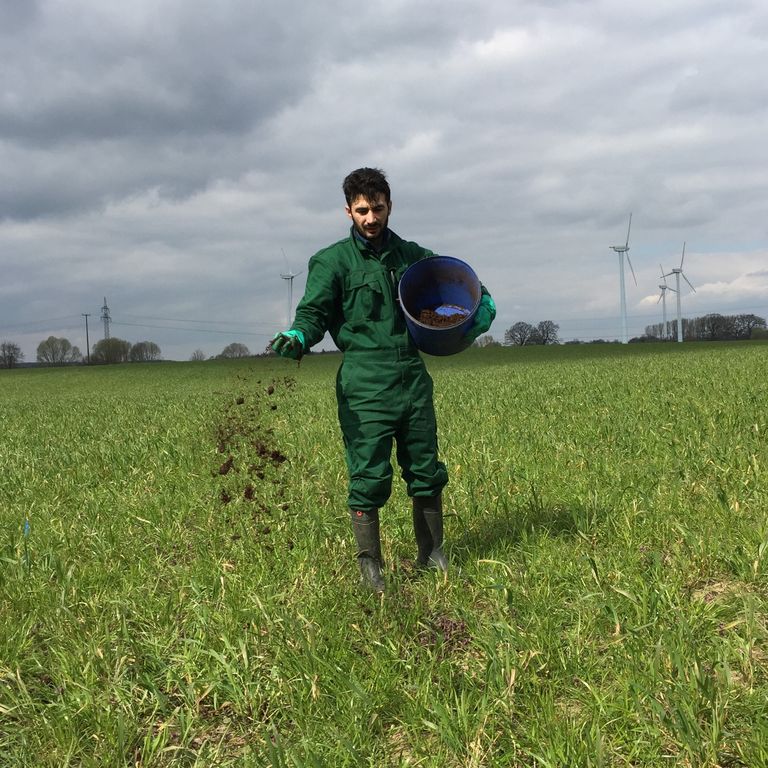Project
Soils as Carbon Sink - Business Models for Climate Goals

Carbon farming
Agricultural soils have high potential to bind additional carbon and can contribute to climate protection. Preserving and enrichment of humus will protect or build up soil fertility. How farmers can adapt their cropland management and how they might be might be paid for this eco-service is analysed in the INTERREG project ‘Carbon Farming’ with participation of the Thünen Institute of Organic Farming.
Background and Objective
Together with farmers the European partners from advisory and research in the North Sea Region will show different possibilities to enrich carbon in soils.
Additionally business models enabling payments to farmers for their activities to enrich carbon in their soils shall be evaluated and developed.
Approach
Three main lines are followed in the project:
1Carbon enrichment in soils
Practical approaches to increase carbon binding in soils shall be demonstrated and the knowledge and awareness of farmers about these processes shall be raised. For this field experiments and demonstration plots as well as workshops for information and discussion are arranged in the participating regions.
During the project carbon content and carbon stock in soils in the explored fields are determined. Biomass and carbon flows of different promising measures for carbon enrichment will be followed. These data help to understand the slow enrichment processes in organic soil carbon. Furthermore it shall be explored in how far business models paying for those carbon increases in soils can be based on measured values or should focus on the activities that are undertaken for improvements. This work package is coordinated by the Thünen-Institute of Organic Farming.
2Business models to valorise carbon enrichment in soils
Current initiatives and programs paying farmers for carbon enrichments in soils are collected. Also new persons, companies and stakeholders are sought to develop baselines for new business models for this.
3 Case studies and transfer in practice
Promising business models for carbon enrichment in soils shall be validated in case studies. Its ecological and economic effects shall be analysed. The knowledge gained in the project shall be made available to farmers and companies, stakeholders and politicians in and outside agribusiness
The project partners in the INTERREG project Carbon Farming recommend „Five promising measures to protect the climate by Carbon Farming“. The permanence of additional organic carbon build-up in soil and the resulting climate effect are variable. But in any case the measures do also promote and maintain soil fertility and biodiversity if applied consistently. Farmers should take action know.
You find the leaflets here:
Results of the Workshop "Carbon Farming" held on 05.03.2020 in Hamburg, please click here (in German)
Report "Inventory of Techniques for Sequestation of Carbon in Agricultural Soils" online: In this report the authors from the INTERREG Carbon Farming project collected pracitival knowledge on suitable techniques an dpotentioals to bind more carbon in farm soils.
please download (pdf): Inventory of Techniques for Sequestation of Carbon in Agricultural Soils
Thünen-Contact

Involved Thünen-Partners
Involved external Thünen-Partners
- Zuidelijke Land- en Tuinbouworganisatie Vereniging (ZLTO)
('s-Hertogenbosch , Niederlande) - INAGRO, Provinciaal Extern Verzelfstandigd Agentschap in Privaatrechtelijke Vorm VZW
(Roeselare, Belgien) -
Stichting Bionext
(Ede, Niederlande) -
Innovatiesteunpunt vzw
(Geel, Belgien) -
Norsk Landbrugsrådgiving Østafjaell
(Åmot, Norwegen) - 3N Niedersachsen Netzwerk Nachwachsende Rohstoffe und Bioökonomie e.V.
(Werlte, Deutschland)
Funding Body
-
European Union (EU)
(international, öffentlich)
Duration
9.2018 - 7.2022
More Information
Project status:
finished
Publications
- 0
Paulsen HM, Jumshudzade Z, Krol M, Jacobs L, Wezel L van, Colombijn-van der Wende K, Heining N, Roels J, Demeyer A, Meulemeester P, Lambrecht E, Coopman F, Kürsten E, Sletsjoee M, Sundet H (2022) The awareness of carbon farming in the agricultural sector, possible and used techniques and business approaches in the North Sea region : short report of two surveys (2019 and 2021) - with data attachment [online]. Interreg North Sea Region, 91 p, zu finden in <https://northsearegion.eu/media/20889/survey_carbon_farming_north_sea_region_interreg_2019_2021.pdf> [zitiert am 02.05.2022]
- 1
Demeyer A, Roels J, Krol M, Heiningen N, Kroeijer Jde, Kürsten E, Lambrecht E, Paulsen HM, Sletsjoee M, Wezel L van (2022) Valorisation of local carbon farming practices : presentation of the show cases in the Carbon Farming project : final report [online]. Interreg North Sea Region, 54 p, zu finden in <https://northsearegion.eu/media/21485/2022-0701-final-rapport-carbon-farming-web.pdf> [zitiert am 13.10.2022]
- 2
Jumshudzade Z, Paulsen HM (2021) Begleitender Versuch zur Kohlenstoffanreicherung in landwirtschaftlichen Böden als klimawirksame Maßnahme. In: Kuratorium für Technik und Bauwesen in der Landwirtschaft (ed) Boden gut machen - neue Ackerbausysteme : KTBL-Tagung vom 16. bis 17. März 2021. Darmstadt: KTBL, pp 109-110
- 3
Jumshudzade Z, Paulsen HM (2021) Carbon Farming - Biomasseanbau und Kohlenstoffanreicherung in landwirtschaftlichen Böden. SchrR Umweltingenieurwesen 105:75-78
- 4
Jumshudzade Z, Paulsen HM (2021) First results of experiments for carbon enrichment with different land use techniques under organic and conventional farming. Thünen Rep 88: 132
- 5
Demeyer A, Roels J, Krol M, Paulsen HM, Klinkert H, Lambrecht E, Jumshudzade Z, Coopman F, Kürsten E, Sundet H, Horluck Berg E (2021) Incentivising carbon farming; policy recommendations from the Carbon Farming project. White paper [online]. Interreg North Sea Region, 39 p, zu finden in <https://northsearegion.eu/media/18284/whitepaper-carbon-farming-digital.pdf> [zitiert am 15.11.2021]
- 6
Paulsen HM (2021) Mehr Humus, besseres Klima. Top Agrar 50(8):50-56
- 7
Kürsten E, Paulsen HM (2020) "Carbon Farming" richtig vermarkten. Land Forst 173(24):16-17
- 8
Paulsen HM (2020) Chapter 1 : Introduction: Carbon sequestration in agricultural soils [online]. In: Paulsen HM (ed) Inventory of techniques for carbon sequestration in agricultural soils. Interreg North Sea Region, pp 3-5, zu finden in <https://northsearegion.eu/media/12543/20200313-cf-rapport.pdf> [zitiert am 19.03.2020]
- 9
Paulsen HM (2020) Chapter 2.1 : Integrating cover crops [online]. In: Paulsen HM (ed) Inventory of techniques for carbon sequestration in agricultural soils. Interreg North Sea Region, pp 6-8, zu finden in <https://northsearegion.eu/media/12543/20200313-cf-rapport.pdf> [zitiert am 19.03.2020]
- 10
Jumshudzade Z, Paulsen HM (2020) Chapter 4.2 : Straw and other harvest residues [online]. In: Paulsen HM (ed) Inventory of techniques for carbon sequestration in agricultural soils. Interreg North Sea Region, pp 25-28, zu finden in <https://northsearegion.eu/media/12543/20200313-cf-rapport.pdf> [zitiert am 19.03.2020]
- 11
Jumshudzade Z, Paulsen HM (2020) Chapter 4.4 : Effects of biochar application in soil [online]. In: Paulsen HM (ed) Inventory of techniques for carbon sequestration in agricultural soils. Interreg North Sea Region, pp 33-36, zu finden in <https://northsearegion.eu/media/12543/20200313-cf-rapport.pdf> [zitiert am 19.03.2020]
- 12
Paulsen HM (ed) (2020) Inventory of techniques for carbon sequestration in agricultural soils [online]. Interreg North Sea Region, 51 p, zu finden in <https://northsearegion.eu/media/12543/20200313-cf-rapport.pdf> [zitiert am 19.03.2020]
- 13
Jacobs A, Heidecke C, Jumshudzade Z, Osterburg B, Paulsen HM, Poeplau C (2020) Soil organic carbon certificates - potential and limitations for private and public climate action. Landbauforsch J Sustainable Organic Agric Syst 70(2):31-35, DOI:10.3220/LBF1605778405000

![[Translate to English:] [Translate to English:]](/media/_processed_/8/e/csm_Bildschirmfoto_2021-03-03_bearb_fc48ac88bf.jpeg)
![[Translate to English:] [Translate to English:]](/media/_processed_/8/e/csm_Bildschirmfoto_2021-03-03_bearb_ba3ec0e9d7.jpeg)











